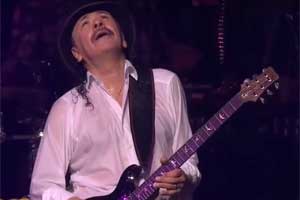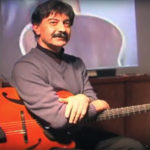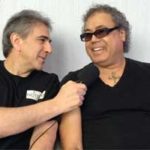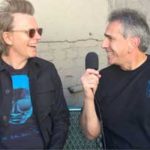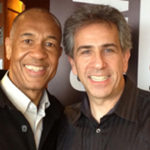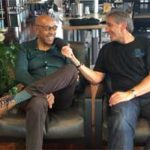Rock legend describes reunion of band’s classic lineup. Could they be back together for good?
By Gary Graff
April 15, 2016
Carlos Santana has hardly been dormant since the original era of Santana ended in 1972. The Mexican-born guitar hero and Rock and Roll Hall of Famer built on that band’s Woodstock-stoked legacy to both explore vast and adventurous musical terrains and achieve great commercial success, peaking with 1999’s Grammy-gobbling Supernatural.
The surviving members of that early lineup remained active, too. Singer-keyboardist Gregg Rolie and guitarist Neal Schon went on to form Journey, which Schon still leads while Rolie is part of Ringo Starr’s All-Starr Band, and drummer Michael Shrieve and percussionist Mike Carabello have maintained a variety of their own bands and projects.
They’ve come back together now for a new album, Santana IV, sounding as fresh, precise and fiery as they did some 44 years ago. The new album features 16 tracks from nearly three times that many ideas the group produced in the studio, with Ronald Isley guesting on a pair of songs.
It’s a rebirth that may well lead to more after an initial blast of shows this month, and it also provides a welcome opportunity to get with Santana himself, a routinely positive chat that can’t help but leave you feeling that even in troubled times, things are a little more right with the world.
FGPO: What was it that attracted you to music, and then guitar, in the first pace?
Santana: When you first see a guitar player – at least for me in Tijuana – I could see the guy had his guitar strap on and he was using it mainly like a tie, but he didn’t know what to do with it. And then you see a guy who grabs it a certain way and squeezes a note and everything stops. There’s no more gravity, no more time. There’s no distractions – just that note and your heart. That’s the difference between guys who I call poseur and performers and then transformers.
There’s a difference between entertainers, performers and real musicians. They’re all good, but Alice Coltrane to me is a person who transmutes and transforms with her music. Michael Jackson and James Brown are probably the best at balancing entertainment and musicality. But there’s other people who don’t do that at all, like John Coltrane and Wayne Shorter and Miles (Davis). They don’t need to do anything like that. What they do is more than enough to become supremely memorable.
So I learned that sometimes you put on a show, but I’m more invested in how can one note from my heart and my fingers helps you see and hear your own song, so when you go home you’re able to validate yourself in a way that you have more trust and believe in yourself.
FGPO: Clearly you mine a deeper well from the people who are your forebears and inspirations.
Santana: John Lee Hooker, B.B. King Tito Puente, Miles … I’m not dropping names; I’m giving reference because all of these people are part of my heart. They all taught me how to tell stories when you take a solo, not just play a bunch of clever, cute, thought-out notes or anything like that. You’ve got to tell a story – Where are you going? What are you trying to say? – and get out there. That’s a gift in itself, to be able to connect to people’s hearts.
My core is Otis Rush and Buddy Guy right now. That’s my core when it comes to the sound that I want my fingers to emanate. I love those two, and that’s my core. I think if I sound closer to what they feel like when I close my eyes, I’m gonna be happy. I going to be happy when I hear the sound back.
FGPO: You published a memoir in 2014, The Universal Tone, that was very frank and forthright about some of the struggles and darker moments in your life. What perspective did writing the book give you?
Santana: I’ve learned to realize that I need to constantly forgive myself, constantly forget your story and live your life. A lot of people get stuck in their story and they don’t live their life anymore. You need to get past the bad stuff and move forward in your life to truly attain fulfillment.
So I’m always working on humility, gratitude and forgiveness. It’s an everyday thing. I do have celestial amnesia. I tend to remember only the highlights, the good stuff. The bad stuff … not that I’m in denial, I just don’t want to be that full time. As Wayne Shorter says, we all have scars and stuff, but I don’t have to, nor do I need to, be miserable or be happy being miserable. In fact, I don’t like being miserable at all. So when that happens, like a dog shakes off water, I like to shake it off and move on.
FGPO: Have you achieved a kind of separation, then, between Carlos and the guy who plays guitar?
Santana: Yes. I don’t want to be attached to this figure thing called “Santana” guy. I like Carlos. Carlos is a nice person. Sometimes it’s hard to distinguish between the performer and the person. I like that Carlos is accepted very, very immediately by Buddy Guy and Eric Clapton. I like that Carlos is trusted. I want to be rounded off. I want to be more like Harry Belafonte or Wayne Shorter or Miles or (John) Coltrane and be a person who is nice to be around, not only when he is on stage but offstage, too.
FGPO: So does this factor in what you hope to achieve with your music?
Santana: I just want Santana to be exactly what we did when we played at Woodstock. We brought a collective commonality with everyone, and that’s what I want. I don’t want to play just for white people or black people or red people or brown people. I want to celebrate all. I take special joy and pleasure in dismantling cynical people. You can’t plant anything in cement, and cynical people to me are like cement, and nothing grows in there. You’re done. I like sharing with people that we have the capacity to make the correct choices every day, so every day can be the best day of your life, no matter what. I love taking a deep breath, and then you’re able to create newness, freshness, genuine, honest, sincere, truthful, real authenticness.
FGPO: You’ve reunited the Santana III lineup for Santana IV. What’s it been like
Santana: Oh, you know, big fun with a capital F. To reunite with these souls and spirits and hearts, the collective fingers, it’s really fun. When I close my eyes and I hear the sound in the room emanating from everybody, it is intact, who we are and what we do from the Fillmore to the Carousel and the Avalon Ballroom to Woodstock and beyond. This is the sound. There’s a chemistry there, just like Paul McCartney and John Lennon and Mick Jagger and Keith Richards. There’s a chemistry that’s just immediate.
FGPO: How did this reunion happen?
Santana: Neal Schon. Neal is the one who very graciously, with a lot of innocence in his eyes, he stayed on me. He seeked me out. It seems like everywhere I went he showed up, in a restaurant or a shopping mall. He had this look in his eyes. It took me about a year to actually just own it and claim it and embrace it and honor it. I finally saw that Neal was looking at me the same way I look at Wayne and Herbie (Hancock), the same way I look at Harry Belafonte. And it disarmed me. I said, “OK, you’re right, Neal. Let’s do something, but let’s call Greg and Michael Carabello and Michael Shrieve. Let’s see if all of us are ready to do this thing. (Schon) wanted to do something with me, but I said, “Why don’t we try the complete package. Let’s make the call and see if Michael and Michael and Gregg Rolie are ready. So we tried that, and as they say all the planets aligned and it’s a green light. We went and did it.
FGPO: This group broke up a little bit abruptly back in 1972. Did you feel like there was unfinished business to attend to?
Santana: It was an unfinished story, yeah. I never looked at it like business. That’s Bill Graham’s and Clive Davis’ hat. I don’t wear that hat. My hat is more like complete songs. So I did look at it like there were unfinished stories that needed to be told. I just felt that there was something we hadn’t visited, but it never went way. It’s kind of like living in New York and then you go to Maui and you jump in the ocean and you realize it was always there – you just haven’t taken the time to get that ticket and get on the plane and dip in the ocean, y’know?
FGPO: Take us in the room the first time you played together again.
Santana: It was in Las Vegas. I have an office/studio and we got together and we started playing and it was just immediate, like watching dolphins jump in the ocean again after being at Sea World or something. We just went in there and started jumping up and down and chirping and laughing, and before we knew it time just passed like crazy and we had first 12 and then 24 and then 42 just jams of songs.
It was no different than all the other albums; they all start with jams, which is like an embryo. Then you develop the eyes and the nose and the arms and the legs and the fingers – but they all start with an embryonic jam. That’s how Santana starts the songs. We don’t sit down and just play a song. We never had that kind of mentality.
FGPO: What WAS different this time?
Santana: What everybody brought this time was for each other, for one another, in honor towards one another of deep appreciation instead of entitlement or fear you’re missing something or you’re not being given credit or you’re not being heard with your songs. My role, from what I remember, was basically being the puzzle-solver. Each song was like a big bunch of pieces on a table, and I always start with the border. Then I get to the middle and they trusted me – Gregg, Neil, Michael and Michael trusted me that I have the clarity of vision to grab the right stuff and make something out of it. So that was my role after awhile, just intuitively, without imposing on anybody. It was very clear I was just seeing the whole picture like that.
FGPO: Did playing with this lineup all these years later give you any sort of perspective on your guitar playing, then and now?
Santana: Oh, man, I have serious confidence in my tone, clarity, confidence, courage – but that’s because I spent a lot of time with John McLaughlin and Alice Coltrane and Wayne Shorter and Herbie. Miles called me all the time when he was here. So my confidence… There’s a difference between confidence and arrogance. Arrogance is fear, confidence is peaceful and with humility. It’s like John Coltrane and Wayne Shorter; they’re so confident they’re, like, totally gentle with compassion and kindness and generosity and consideration. I just feel like I’ve really grown as a man.
FGPO: You mention having done a lot more songs than are on the Santana IV album. Do you think this group is a going concern again?
Santana: Y’know, that’s not up to me. That’s more to develop. Gregg is really involved with Ringo (Starr) and Neal is really involved with Journey. I’m not into pushing things. I’ll see what they want to do. We just did this. I would love to (do more) but it’s all how it unfolds ’cause I don’t like pushing things. I’d rather play it out more like Desmond Tutu would say – “Work in progress, more as it develops.”
